Foreign Capital and Economic Growth; Presentation by Raghuram Rajan, Economic Counsellor and Director of the Research Department, based on a paper written by Eswar Prasad, Raghuram Rajan, and Arvind Subramanian
August 25, 2006
At a Conference Organized by the Federal Reserve Bank
of Kansas City
Jackson Hole, Wyoming
August 25, 2006
Good morning. Let me say at the outset that what follows are the authors' views and should not be seen as the views of the International Monetary Fund or its management. The essential question our paper asks is, "Does foreign capital play a helpful, benign, or malign role in the process of economic growth?"
The theory is simple — First, capital should flow from rich countries to poor countries — because in the neoclassical model, the marginal product of a unit of capital is much higher in poor countries that are typically labor abundant and capital poor. Second, more productive poor countries should attract more foreign capital because they have the ability to use it better. And third, because it adds investible resources, and because of the collateral benefits of foreign capital such as bringing in new technologies of production and control, greater use of foreign capital should be associated with more growth.
What is the evidence? In what follows, I will show you evidence that capital does not flow from rich to poor countries in the relative quantities it used to — surprising given that financial markets have been getting better. Moreover, it is not also true that amongst non-industrial countries, the most productive get the most capital inflows. Finally, for non-industrial countries, there does not seem to be a positive association between growth and reliance on foreign capital. In fact, there is generally a negative correlation suggesting that non-industrial countries that are more reliant on foreign capital grow less. For industrial countries, though, there is a positive association.
Correlation is not causation, and indeed there are both benign and malign explanations of these correlations. What seems to be clear is that non-industrial countries do not have tremendous absorptive capacity for foreign capital in general, though particular forms of foreign capital such as FDI may be useful. Put differently, the relatively low use of foreign capital by successful developing countries may have more to do with their low demand for foreign capital than with a willingness of developed country creditors to supply it.
One reason for the low demand may be their financial system is underdeveloped so that when they have growth opportunities, the extra domestic savings they generate are largely adequate to cover the investment that can profitably be financed. This is a benign explanation for the limited role of foreign capital in development. More malign is if foreign capital inflows cause overvaluation of the exchange rate, thus reducing the competitiveness of the economy, and thus reducing manufacturing exports and undermining a traditional stepping stone to growth. There are also concerns about foreign capital we do not address, such as its potentially higher volatility, which may make countries other than the really needy stay away from it.
Our conclusion is therefore that in the long run, capital account opening is unlikely to help poor countries grow by providing resources in excess of what is available in the domestic economy — notwithstanding examples of foreign capital led booms and busts -- though it may help in other ways. Foreign capital is no panacea for capital-poor countries. Put differently, the current patterns of flow of capital in the global economy, though seemingly perverse, may not be so, at least given the financial and institutional constraints non-industrial countries have. That does not mean these flows are either optimal, safe, or sustainable in the long run.
Let me now turn to the evidence. The paradox Lucas noted was that capital does not flow in the requisite quantities from rich to poor countries. Indeed, matters have gotten worse recently. Capital seems to be flowing uphill as the next slide shows.
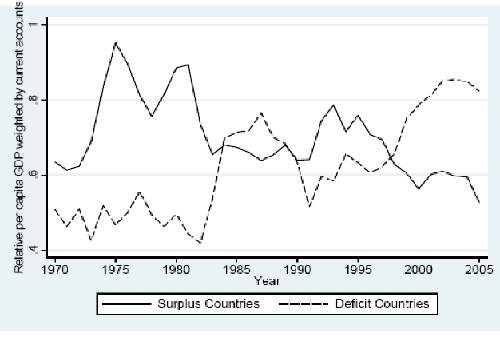
The dark line represents weighted average relative incomes of countries exporting capital (that is, running current account surpluses). Income is measured relative to the richest country in that year, and the weight on each country's income is the size of its surplus relative to the total surplus. The dark line has been falling while the dotted line, representing the weighted average income of countries using capital (that is, running current account deficits), has been rising. The dotted line is now significantly above the dark line — simply put, the poor are now exporting capital to the rich. Note that this is not new. It was also true in the mid 1980s.
Since these periods are also when the U.S. was running large deficits, what does the picture look like when we drop the U.S. from deficit countries. On the next slide, the picture looks similar with a narrowing of the income gap between capital exporters and capital receivers in the mid 1980s, and again since the late 1990s.
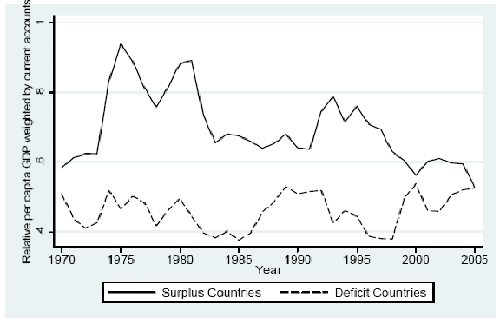
What we have seen so far are overall flows. Foreign Direct Investment (FDI) flows by themselves do behave more in accordance with the models as the next slide suggests--the weighted-average relative income of countries experiencing net FDI inflows is generally lower than that of FDI-exporting countries, though the relative income of senders has been trending down while the relative income of recipients has been moving up since the mid 1990s. So in sum, rich countries are increasingly net users of foreign capital while poorer countries are increasingly net suppliers.
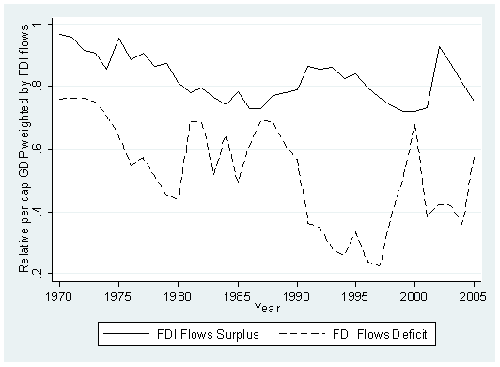
The next question is who amongst poor countries gets the most capital. This is an important question because some have argued that the reason poor countries export capital is because private investors there do not see good investment opportunities in their own countries and therefore invest abroad — for example, invest in the US, which then invests it back as FDI. Some therefore call the U.S. the global venture capitalist. There are problems with this argument taken at face value, including the fact that private investors in many poor countries do not have access directly to foreign investment opportunities — they invest in domestic banks, which invest in the central bank, which then invests abroad. It is not clear that private investors in these countries should have substantially greater confidence in domestic financial institutions (or in their governments) than in corporations.
Be that as it may there is a deeper problem. In the next slide, we divide non-industrial countries based on growth into three groups, each with approximately the same total population. We keep aside populous India and China. The theory would say that the high growth countries should attract the most capital because they have the best investment opportunities (and also are the most credit worthy). The reality is very different.
The Allocation of Capital Flows to Non-Industrial Countries 1970-2004
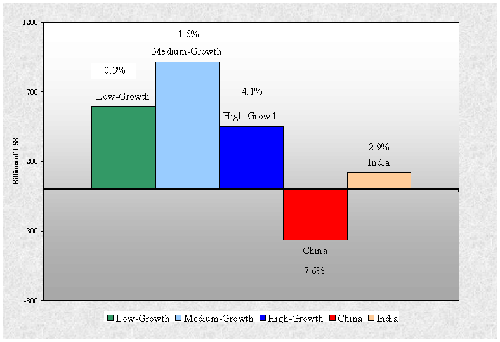
High growth countries use less foreign capital than even low growth countries. China, the fastest growing country of them all, is a net exporter of capital between 1970 and 2004.
In fact, if you turn to the next slide, both in the heyday of capital flows to poor countries from 1985 to 1997, and in the most recent years, the flows have been inversely proportional to growth. Between 2000 and 2004, we see the well known phenomenon of reserve build up as all but the slowest growing poor countries export capital.
The Allocation of Capital Flows to Non-Industrial Countries
1985-1997 and 2000-2004
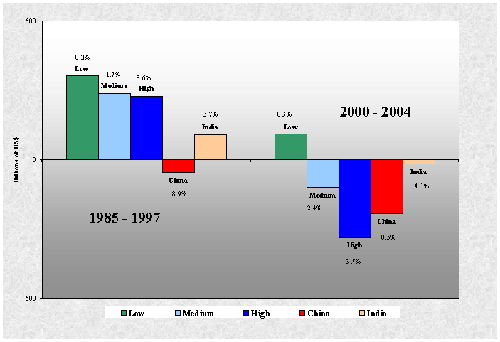
Note again in the next slide that FDI is different. Here it does seem that over long periods, more FDI goes to the faster growing countries, but again there is a reversal in the most recent years, with the fastest growing countries getting less FDI than slower growing countries. It is suggestive that in the period 2000-2004, countries are taking in FDI, even while exporting savings on net, suggesting that FDI has benefits over and above simply augmenting the resource base.
The Allocation of Net FDI Flows to Non-Industrial Countries
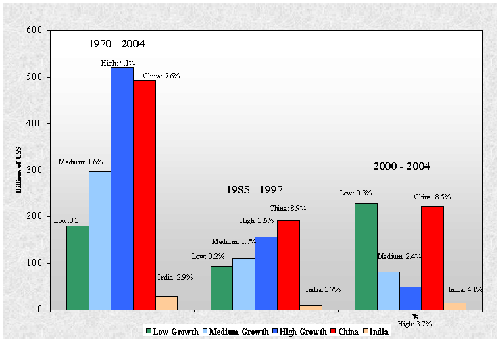
This immediately leads to the question: Do countries that rely more on foreign capital grow faster in the long run? It turns out, that this is not so.
Indeed , as the next slide shows, if you plot growth over a 30 year period against current account balances, you find a positive correlation for non-industrial countries. Countries that use less foreign finance, or export more savings, grow faster. Clearly, one might expect this for the countries that are development disasters and totally reliant on foreign aid.
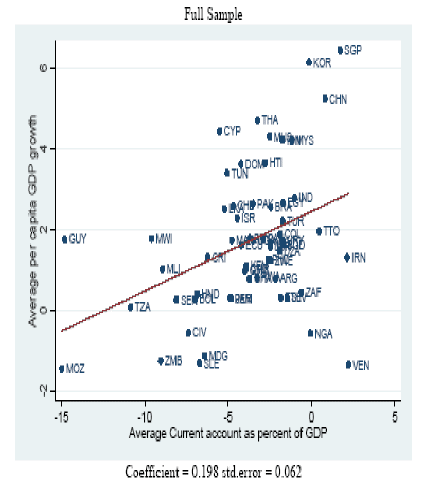
To check for this possibility, we drop countries that got annual aid of more than 10 percent of GDP. It turns out the correlation is even stronger.
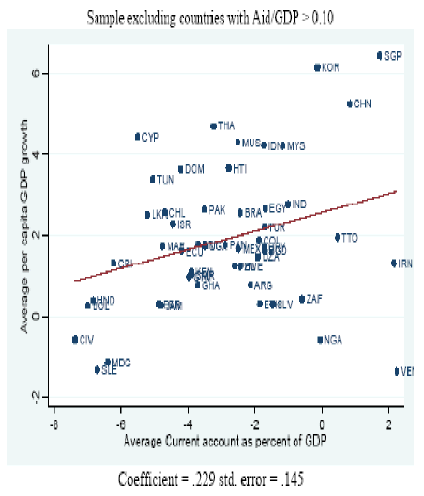
The positive association between current account balances and growth holds in a more formal setting. As the next slide shows, in a standard regression of long run growth a la Bosworth and Collins, the coefficient on the current account balance is positive and statistically significant even after controlling for typical determinants of growth (initial income, trade policy, fiscal policy, institutional quality, life expectancy, and dummies for oil exporters and sub-Saharan Africa).
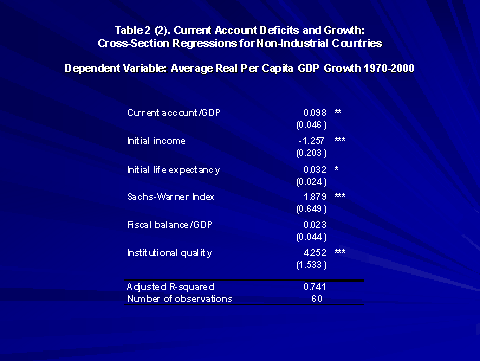
Is this relationship robust? Turning to the next slide, even if we drop countries that have high levels of official financing (aid-to-GDP ratio greater than 10 percent), we find that the relationship holds for the whole sample and also for the three regions separately—Asia, Africa, and Latin America.
Current Account Balances and Growth in Non-Industrial Countries
1970-2000 - Excluding Countries with Aid/GDP>10 Percent
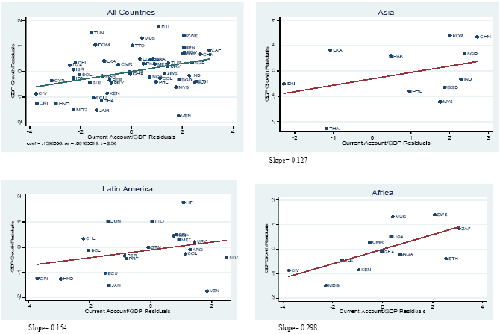
So far, we have looked just at non-industrial countries. The table in the next slide suggests when we include industrial countries to see if the association between current accounts and growth is different for these two countries, we find that indeed that is the case. The correlation is negative for industrial countries (a 1 percentage point increase in the ratio of the current account balance to GDP decreases growth by 0.14 percent per year); while this correlation is positive for both emerging markets and developing countries.
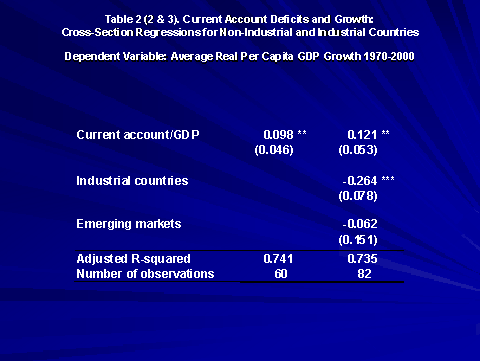
Finally, a very simple way of assessing whether foreign capital matters is to look at countries with high and low investments and high and low savings, to see what combination of savings and investment matter for growth. The chart in the next slide shows that countries that invest more grow more than countries that invest less; but it is countries that invest more and save more (that is rely less on foreign capital) that do the best of all. In fact, within countries that invest more, those that save more (and thus run lower current account deficits) grow at a rate of about 1 percent a year more than countries that save less.
Current Account, Investment and Growth
in Non-Industrial Countries
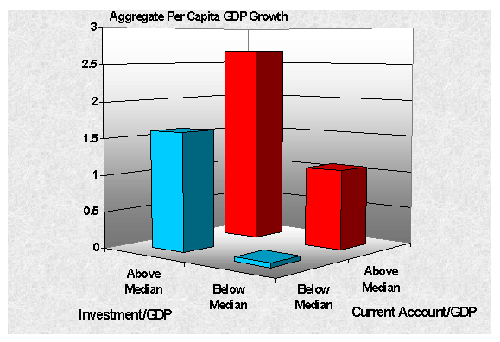
All this suggests that domestic savings rather than foreign savings are critical for growth.
Indeed, turning to the table in the next slide, we find in the second column that controlling for domestic savings in our baseline regression eliminates the effect of the current account on growth but controlling for investment does not. We have conducted a number of robustness checks given that savings or investment could be mismeasured to verify this finding is robust. This suggests that domestic savings are an important correlate with growth.
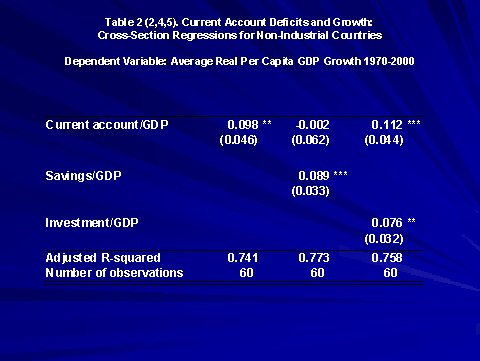
Interestingly, while this is true for non-industrial countries, it is not the case for industrial countries. Why so?
There are at least three potential explanations for this finding, all to do with the fact that non-industrial countries do not have much capacity to absorb foreign capital.
The first relates to the domestic financial system. In industrial countries that have well developed financial systems, a sustained increase in productivity would not only result in more investment — as firms borrow to take advantage of investment opportunities — but also more consumption as consumers borrow to consume in anticipation of their higher income. This implies more financing from abroad or current account deficits.
In non-industrial countries, by contrast, a productivity shock creates higher incomes, but is filtered by a weak financial system into weaker investment growth and greater savings growth because firms are constrained to self-finance investment and households cannot borrow much against higher future income to increase consumption. It is possible that greater productivity growth shrinks the current account deficit, and even results in surplus savings.
One implication is that savings should grow more than investment around the time when non-industrial countries experience growth spurts, typically due to surges in productivity. As the next slide suggests, this is what we find for a group of developing countries during such growth spurts (as identified by Hausman, Rodrik and Pritchett). As you can see from the chart below, savings grows faster than investment during a growth spurt,
Savings-Investment Balances around Growth Spurts:
Non-Industrial Countries 1970-2000
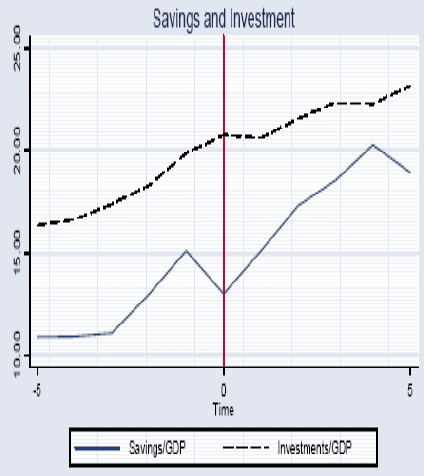
which explains why the current account deficit, narrows.
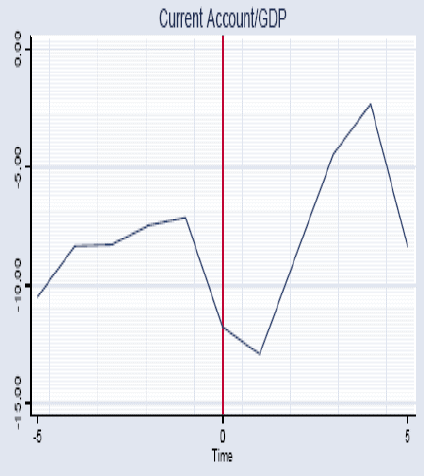
Another implication is that the correlation between growth and the current account (alternatively, domestic savings) should be stronger in countries with weaker financial systems. This is indeed what we find in the 2nd and 3rd columns in the next slide where countries with indicators of financial development below the median have about twice the coefficient on the current account as countries with financial development above the median.
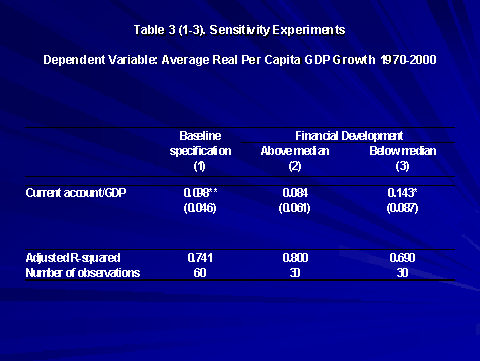
At the micro level, we find that in countries with weaker financial systems, additional foreign resources do not translate into stronger growth of financially-dependent industries. Again, this suggests countries with low financial development do not have the absorptive capacity for foreign savings.
A second explanation of the importance of domestic savings relative to foreign financing relates to the exchange rate. There is increasing evidence that sustained growth has been associated with the development of the domestic manufacturing sector which in turn requires that its competitiveness not be undermined by overvalued exchange rates. We find evidence that developing countries that rely on foreign capital are more prone to overvaluation. Thus, our result of a positive correlation between the current account and growth could be explained as follows: strong capital inflows lead to an overvalued exchange rate, hurting manufacturing exports, which in turn could reduce long run growth — perhaps because manufacturing growth is a key stepping stone to development. By contrast, for industrial countries, we do not find that capital inflows affect the extent of exchange rate overvaluation, nor do we find that overvaluation has any effect on growth. Industrial countries seem to have more absorptive capacity for foreign capital.
The next explanation relates to volatility. Capital flows are volatile which in turn lead to financial crises, setting back sustained growth. We have relatively little to add here except to note that a number of studies show that there is no systematic correlation between openness to capital and volatility. Moreover, the volatility argument is not easily squared with the fact that the negative correlation between capital flows and growth is also present for sub-Saharan Africa, which relies on official capital that tends to be less volatile than private capital.
So, to summarize: The implication of our analysis is that successful developing countries have been less reliant on foreign capital because of their limited capacity to absorb it. Our paper suggests that the anomaly of poor countries not attracting capital, or occasionally even financing rich countries, may not really hurt the former's growth, at least conditional on their existing institutional and financial structures. Opening up to foreign capital may not help much unless the domestic financial sector and the tradable sector also develop.
But there is a dilemma for policy makers here. Even though reformers in developing countries might want to wait to achieve a certain level of financial development before pushing for financial integration, the prospect of financial integration and ensuing competition may be needed to spur domestic financial development. One approach worth considering might be a firm commitment to integrate financial markets at a definite future date (as China has done in the banking sector in the context of the WTO), thus giving time for the domestic financial system to develop without possible adverse effects from capital inflows, even while giving participants the incentive to press for it by suspending the sword of future foreign competition over their heads. Another possibility is to allow more outflows in a controlled manner, so that the pressure on the exchange rate from inflows is diminished.
Finally, our analysis offers an alternative view of the global current account imbalances that have built up recently. In the last decade or so, the U.S. has experienced a tremendous surge in productivity. What is less well known is that non-industrial countries have also experienced a large surge in productivity. There has indeed been a global productivity shock, and the resulting pattern of current accounts might reflect the differing patterns of financial sector development. Countries with strong financial systems have taken advantage by investing and consuming more, running deficits (the US being the best example). Countries with relatively weaker financial systems on the other hand have increased savings and been more conservative on investment, with this tendency accentuated by the experience of the Asian financial crisis and the indiscriminate lending and investment leading up to it. Some industrial countries such as a number in the Euro region have not experienced a similar productivity surge, and thus have been left out of the global tango.
Imbalances may therefore be a consequence of deep structural deficiencies, but given these deficiencies might be an equilibrium outcome. Imbalances will come down as productivity growth slows in the United States, and consumption and investment adjust in emerging markets to the higher productivity. Financial sector reform will help here. But there are risks associated with this equilibrium. When a large country runs a trade deficit of 6 percent of GDP for a long time, it will eventually find financing harder to come by. Poor countries who have built up large foreign asset holdings run the risk of large exchange losses at that point. Even if financial markets stay tolerant, protectionist politicians may pull the trigger. A smooth unwinding is in everyone's interest, and to the extent public policy can help, a risk management approach suggests it should. One should not confuse the words "equilibrium", "stability", and "sustainability."
1 Eswar Prasad is Chief of the Financial Studies Division of the Research Department, Raghuram Rajan is Economic Counsellor and Director of the Research Department, and Arvind Subramanian is Assistant Director for the Macroeconomic Studies Division of the Research Department at the International Monetary Fund. The paper on which this presentation is based is available from the authors. We are grateful to Menzie Chinn and Gian Maria Milesi-Ferretti for helpful comments and discussions, and to Manzoor Gill, Ioannis Tokatlidis and Junko Sekine for excellent research assistance. The views expressed in this paper are those of the authors, and do not necessarily represent those of the IMF, its management, or its Executive Board.
|
Correlation is not causation, and indeed there are both benign and malign explanations of these correlations. What seems to be clear is that non-industrial countries do not have tremendous absorptive capacity for foreign capital in general, though particular forms of foreign capital such as FDI may be useful. Put differently, the relatively low use of foreign capital by successful developing countries may have more to do with their low demand for foreign capital than with a willingness of developed country creditors to supply it. One reason for the low demand may be their financial system is underdeveloped so that when they have growth opportunities, the extra domestic savings they generate are largely adequate to cover the investment that can profitably be financed. This is a benign explanation for the limited role of foreign capital in development. More malign is if foreign capital inflows cause overvaluation of the exchange rate, thus reducing the competitiveness of the economy, and thus reducing manufacturing exports and undermining a traditional stepping stone to growth. There are also concerns about foreign capital we do not address, such as its potentially higher volatility, which may make countries other than the really needy stay away from it. Our conclusion is therefore that in the long run, capital account opening is unlikely to help poor countries grow by providing resources in excess of what is available in the domestic economy — notwithstanding examples of foreign capital led booms and busts -- though it may help in other ways. Foreign capital is no panacea for capital-poor countries. Put differently, the current patterns of flow of capital in the global economy, though seemingly perverse, may not be so, at least given the financial and institutional constraints non-industrial countries have. That does not mean these flows are either optimal, safe, or sustainable in the long run. Let me now turn to the evidence. The paradox Lucas noted was that capital does not flow in the requisite quantities from rich to poor countries. Indeed, matters have gotten worse recently. Capital seems to be flowing uphill as the next slide shows.
The dark line represents weighted average relative incomes of countries exporting capital (that is, running current account surpluses). Income is measured relative to the richest country in that year, and the weight on each country's income is the size of its surplus relative to the total surplus. The dark line has been falling while the dotted line, representing the weighted average income of countries using capital (that is, running current account deficits), has been rising. The dotted line is now significantly above the dark line — simply put, the poor are now exporting capital to the rich. Note that this is not new. It was also true in the mid 1980s. Since these periods are also when the U.S. was running large deficits, what does the picture look like when we drop the U.S. from deficit countries. On the next slide, the picture looks similar with a narrowing of the income gap between capital exporters and capital receivers in the mid 1980s, and again since the late 1990s.
What we have seen so far are overall flows. Foreign Direct Investment (FDI) flows by themselves do behave more in accordance with the models as the next slide suggests--the weighted-average relative income of countries experiencing net FDI inflows is generally lower than that of FDI-exporting countries, though the relative income of senders has been trending down while the relative income of recipients has been moving up since the mid 1990s. So in sum, rich countries are increasingly net users of foreign capital while poorer countries are increasingly net suppliers.
The next question is who amongst poor countries gets the most capital. This is an important question because some have argued that the reason poor countries export capital is because private investors there do not see good investment opportunities in their own countries and therefore invest abroad — for example, invest in the US, which then invests it back as FDI. Some therefore call the U.S. the global venture capitalist. There are problems with this argument taken at face value, including the fact that private investors in many poor countries do not have access directly to foreign investment opportunities — they invest in domestic banks, which invest in the central bank, which then invests abroad. It is not clear that private investors in these countries should have substantially greater confidence in domestic financial institutions (or in their governments) than in corporations. Be that as it may there is a deeper problem. In the next slide, we divide non-industrial countries based on growth into three groups, each with approximately the same total population. We keep aside populous India and China. The theory would say that the high growth countries should attract the most capital because they have the best investment opportunities (and also are the most credit worthy). The reality is very different. The Allocation of Capital Flows to Non-Industrial Countries 1970-2004
High growth countries use less foreign capital than even low growth countries. China, the fastest growing country of them all, is a net exporter of capital between 1970 and 2004. In fact, if you turn to the next slide, both in the heyday of capital flows to poor countries from 1985 to 1997, and in the most recent years, the flows have been inversely proportional to growth. Between 2000 and 2004, we see the well known phenomenon of reserve build up as all but the slowest growing poor countries export capital. The Allocation of Capital Flows to Non-Industrial Countries
Note again in the next slide that FDI is different. Here it does seem that over long periods, more FDI goes to the faster growing countries, but again there is a reversal in the most recent years, with the fastest growing countries getting less FDI than slower growing countries. It is suggestive that in the period 2000-2004, countries are taking in FDI, even while exporting savings on net, suggesting that FDI has benefits over and above simply augmenting the resource base. The Allocation of Net FDI Flows to Non-Industrial Countries
This immediately leads to the question: Do countries that rely more on foreign capital grow faster in the long run? It turns out, that this is not so. Indeed , as the next slide shows, if you plot growth over a 30 year period against current account balances, you find a positive correlation for non-industrial countries. Countries that use less foreign finance, or export more savings, grow faster. Clearly, one might expect this for the countries that are development disasters and totally reliant on foreign aid.
To check for this possibility, we drop countries that got annual aid of more than 10 percent of GDP. It turns out the correlation is even stronger.
The positive association between current account balances and growth holds in a more formal setting. As the next slide shows, in a standard regression of long run growth a la Bosworth and Collins, the coefficient on the current account balance is positive and statistically significant even after controlling for typical determinants of growth (initial income, trade policy, fiscal policy, institutional quality, life expectancy, and dummies for oil exporters and sub-Saharan Africa).
Is this relationship robust? Turning to the next slide, even if we drop countries that have high levels of official financing (aid-to-GDP ratio greater than 10 percent), we find that the relationship holds for the whole sample and also for the three regions separately—Asia, Africa, and Latin America. Current Account Balances and Growth in Non-Industrial Countries
So far, we have looked just at non-industrial countries. The table in the next slide suggests when we include industrial countries to see if the association between current accounts and growth is different for these two countries, we find that indeed that is the case. The correlation is negative for industrial countries (a 1 percentage point increase in the ratio of the current account balance to GDP decreases growth by 0.14 percent per year); while this correlation is positive for both emerging markets and developing countries.
Finally, a very simple way of assessing whether foreign capital matters is to look at countries with high and low investments and high and low savings, to see what combination of savings and investment matter for growth. The chart in the next slide shows that countries that invest more grow more than countries that invest less; but it is countries that invest more and save more (that is rely less on foreign capital) that do the best of all. In fact, within countries that invest more, those that save more (and thus run lower current account deficits) grow at a rate of about 1 percent a year more than countries that save less. Current Account, Investment and Growth
All this suggests that domestic savings rather than foreign savings are critical for growth. Indeed, turning to the table in the next slide, we find in the second column that controlling for domestic savings in our baseline regression eliminates the effect of the current account on growth but controlling for investment does not. We have conducted a number of robustness checks given that savings or investment could be mismeasured to verify this finding is robust. This suggests that domestic savings are an important correlate with growth.
Interestingly, while this is true for non-industrial countries, it is not the case for industrial countries. Why so? There are at least three potential explanations for this finding, all to do with the fact that non-industrial countries do not have much capacity to absorb foreign capital. The first relates to the domestic financial system. In industrial countries that have well developed financial systems, a sustained increase in productivity would not only result in more investment — as firms borrow to take advantage of investment opportunities — but also more consumption as consumers borrow to consume in anticipation of their higher income. This implies more financing from abroad or current account deficits. In non-industrial countries, by contrast, a productivity shock creates higher incomes, but is filtered by a weak financial system into weaker investment growth and greater savings growth because firms are constrained to self-finance investment and households cannot borrow much against higher future income to increase consumption. It is possible that greater productivity growth shrinks the current account deficit, and even results in surplus savings. One implication is that savings should grow more than investment around the time when non-industrial countries experience growth spurts, typically due to surges in productivity. As the next slide suggests, this is what we find for a group of developing countries during such growth spurts (as identified by Hausman, Rodrik and Pritchett). As you can see from the chart below, savings grows faster than investment during a growth spurt, Savings-Investment Balances around Growth Spurts:
which explains why the current account deficit, narrows.
Another implication is that the correlation between growth and the current account (alternatively, domestic savings) should be stronger in countries with weaker financial systems. This is indeed what we find in the 2nd and 3rd columns in the next slide where countries with indicators of financial development below the median have about twice the coefficient on the current account as countries with financial development above the median.
At the micro level, we find that in countries with weaker financial systems, additional foreign resources do not translate into stronger growth of financially-dependent industries. Again, this suggests countries with low financial development do not have the absorptive capacity for foreign savings. A second explanation of the importance of domestic savings relative to foreign financing relates to the exchange rate. There is increasing evidence that sustained growth has been associated with the development of the domestic manufacturing sector which in turn requires that its competitiveness not be undermined by overvalued exchange rates. We find evidence that developing countries that rely on foreign capital are more prone to overvaluation. Thus, our result of a positive correlation between the current account and growth could be explained as follows: strong capital inflows lead to an overvalued exchange rate, hurting manufacturing exports, which in turn could reduce long run growth — perhaps because manufacturing growth is a key stepping stone to development. By contrast, for industrial countries, we do not find that capital inflows affect the extent of exchange rate overvaluation, nor do we find that overvaluation has any effect on growth. Industrial countries seem to have more absorptive capacity for foreign capital. The next explanation relates to volatility. Capital flows are volatile which in turn lead to financial crises, setting back sustained growth. We have relatively little to add here except to note that a number of studies show that there is no systematic correlation between openness to capital and volatility. Moreover, the volatility argument is not easily squared with the fact that the negative correlation between capital flows and growth is also present for sub-Saharan Africa, which relies on official capital that tends to be less volatile than private capital. So, to summarize: The implication of our analysis is that successful developing countries have been less reliant on foreign capital because of their limited capacity to absorb it. Our paper suggests that the anomaly of poor countries not attracting capital, or occasionally even financing rich countries, may not really hurt the former's growth, at least conditional on their existing institutional and financial structures. Opening up to foreign capital may not help much unless the domestic financial sector and the tradable sector also develop. But there is a dilemma for policy makers here. Even though reformers in developing countries might want to wait to achieve a certain level of financial development before pushing for financial integration, the prospect of financial integration and ensuing competition may be needed to spur domestic financial development. One approach worth considering might be a firm commitment to integrate financial markets at a definite future date (as China has done in the banking sector in the context of the WTO), thus giving time for the domestic financial system to develop without possible adverse effects from capital inflows, even while giving participants the incentive to press for it by suspending the sword of future foreign competition over their heads. Another possibility is to allow more outflows in a controlled manner, so that the pressure on the exchange rate from inflows is diminished. Finally, our analysis offers an alternative view of the global current account imbalances that have built up recently. In the last decade or so, the U.S. has experienced a tremendous surge in productivity. What is less well known is that non-industrial countries have also experienced a large surge in productivity. There has indeed been a global productivity shock, and the resulting pattern of current accounts might reflect the differing patterns of financial sector development. Countries with strong financial systems have taken advantage by investing and consuming more, running deficits (the US being the best example). Countries with relatively weaker financial systems on the other hand have increased savings and been more conservative on investment, with this tendency accentuated by the experience of the Asian financial crisis and the indiscriminate lending and investment leading up to it. Some industrial countries such as a number in the Euro region have not experienced a similar productivity surge, and thus have been left out of the global tango. Imbalances may therefore be a consequence of deep structural deficiencies, but given these deficiencies might be an equilibrium outcome. Imbalances will come down as productivity growth slows in the United States, and consumption and investment adjust in emerging markets to the higher productivity. Financial sector reform will help here. But there are risks associated with this equilibrium. When a large country runs a trade deficit of 6 percent of GDP for a long time, it will eventually find financing harder to come by. Poor countries who have built up large foreign asset holdings run the risk of large exchange losses at that point. Even if financial markets stay tolerant, protectionist politicians may pull the trigger. A smooth unwinding is in everyone's interest, and to the extent public policy can help, a risk management approach suggests it should. One should not confuse the words "equilibrium", "stability", and "sustainability." 1 Eswar Prasad is Chief of the Financial Studies Division of the Research Department, Raghuram Rajan is Economic Counsellor and Director of the Research Department, and Arvind Subramanian is Assistant Director for the Macroeconomic Studies Division of the Research Department at the International Monetary Fund. The paper on which this presentation is based is available from the authors. We are grateful to Menzie Chinn and Gian Maria Milesi-Ferretti for helpful comments and discussions, and to Manzoor Gill, Ioannis Tokatlidis and Junko Sekine for excellent research assistance. The views expressed in this paper are those of the authors, and do not necessarily represent those of the IMF, its management, or its Executive Board. |
IMF EXTERNAL RELATIONS DEPARTMENT
| Public Affairs | Media Relations | |||
|---|---|---|---|---|
| E-mail: | publicaffairs@imf.org | E-mail: | media@imf.org | |
| Fax: | 202-623-6220 | Phone: | 202-623-7100 | |


